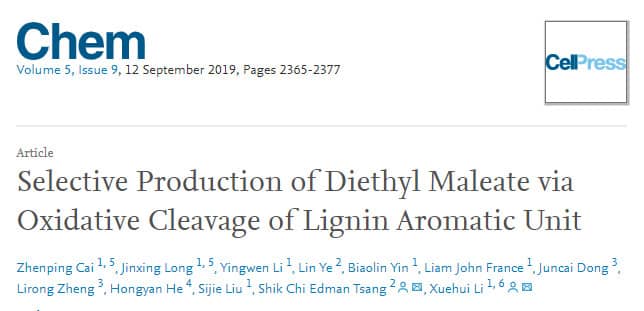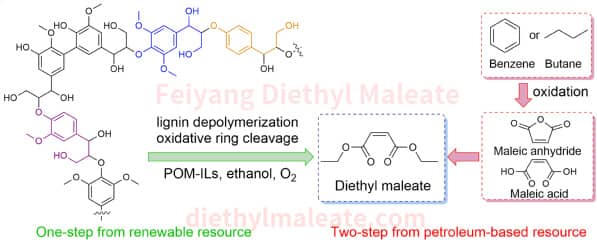
At present, most of the bulk chemicals containing carbon are obtained from non-renewable fossil resources such as petroleum and coal through a complex transformation process, which brings a series of problems such as greenhouse effect, climate change and environmental pollution. Since biomass resources are widely sourced, renewable and their constituent elements are close to those of current bulk organic chemicals, it is significant to develop technologies for efficient conversion of biomass into high value-added chemicals. Lignin is an important component of biomass and a by-product of industrial pulp and paper and bioethanol production process with huge yield. However, lignin has a complex structure, difficult to depolymerize and low selectivity, which is a bottleneck for efficient biomass application. In the chemical industry, maleate is an important class of bulk chemicals, which is traditionally produced by the oxidation of petroleum-based feedstocks such as benzene or butane, with problems such as selectivity to be improved, safety and environmental pressure. In response, Prof. Xuehui Li’s team developed a new catalyst system to selectively break the benzene ring containing structural units within the lignin molecule and coupled with enhanced modes such as in situ esterification to develop a new route for the efficient depolymerization and selective conversion of lignin to diethyl maleate.

In the course of the study, it was found by XAS and PXRD analyses that partial substitution of transition metal ions can lead to the transformation of the phosphotungstic acid Pcca structure to Pncn structure, and the transformation of the 6-coordinated W/Cu structure to the 5-coordinated W/Cu structure, which is the catalytic oxidation active center of the process, and the 5-coordinated W/Cu structure provides empty orbitals to bind oxygen during the oxidation reaction The 5-ligand W/Cu structure provides empty orbitals to combine with oxygen during the oxidation reaction to reconvert to the distorted 6-ligand structure for the highly active oxidation process. The high-temperature dissolution and low-temperature precipitation of the catalyst can solve the problems of difficult contact between biomass macromolecules and the catalyst and recycling, etc. The results provide a new pathway to replace petroleum-based feedstock for the selective conversion of lignin into high-value-added products.
